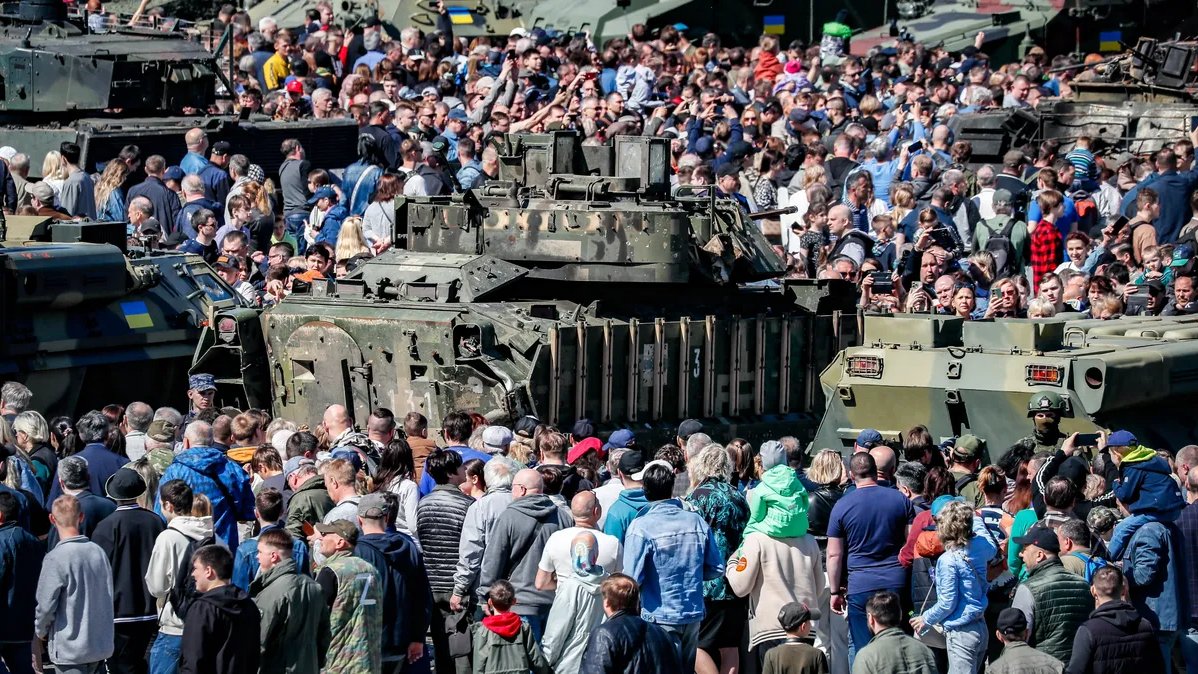In early May, an open-air exhibition of war trophies, which state news agencies claimed were captured by Russian forces in Ukraine, opened on Moscow’s Poklonnaya Hill, one of the city’s highest points, much of which is now given over to Victory Park, which celebrates various 19th and 20th century Russian military victories.
The exhibition features tanks, APCs and other armed vehicles, as well as firearms and even mines. Novaya Gazeta Europe made an outing to the exhibition during the recent May holidays to witness pro-war Russians celebrating Victory Day by proudly inspecting captured NATO military hardware.
‘Live, work and fight’
A cyclone from the east and an anticyclone from the west hit the Russian capital over the May holidays, bringing snow on 8 May, and leaving the dignitaries attending the Victory Day parade on Moscow’s Red Square the next day to freeze in the cold.
The weather doesn’t appear to have put off visitors to Poklonnaya Hill, however, and the metro is packed to the gills. At the exit to the Park Pobedy metro station, where cover bands can usually be found singing Western hits, an elderly man wishes everyone a happy Victory Day and performs songs by Pesnyary, a Soviet group from the seventies. A voice can be heard from the speakers: a pro-government actor breathlessly urges listeners to “live, work and fight like they did”. Flags bearing portraits of Stalin with the words “Thanks for victory, Granddad” drift by, followed by the banner of the so-called “Luhansk People’s Republic”.
Poklonnaya Hill’s Victory Park was opened on 9 May 1995 with the first parade in honour of Victory Day in recent Russian history. The first part of the parade was held on Red Square, where the guests included world leaders and the secretary generals of both the UN and NATO. A poster at the History Museum depicting Soviet and US soldiers even proclaimed “Glory to the peoples of the countries that conquered fascism!”.
By contrast, in 2024, Moscow’s Victory Day parade was attended by such luminaries as the dictators of Belarus, Kazakhstan, Kyrgyzstan, Uzbekistan, Tajikistan, Turkmenistan, Cuba, Laos and Guinea-Bissau. Indeed, on Poklonnaya Hill today, all that remains of the West’s presence are various trophies and the odd lone statue of allied soldiers who fought Hitler.
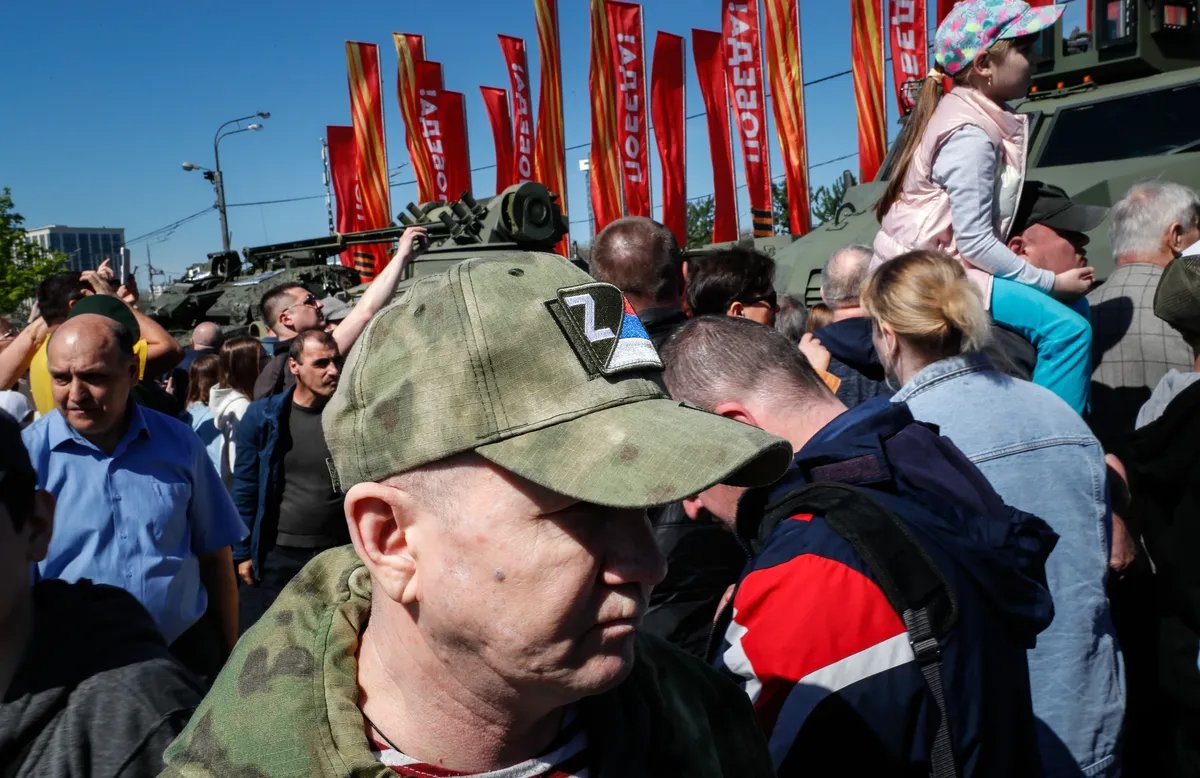
Photo: EPA-EFE/YURY KOCHETKOV
‘Even the line’s shaped like the letter Z!’
Approaching the exhibit, it gradually becomes clear that there are almost certainly more police officers here than there were at Alexey Navalny’s funeral, standing in a line spaced at five-metre intervals, from where they scrutinise the faces of passersby. At the metal detector by the entrance, army cadets discuss where they should have lunch, deciding to avoid the “pathetic” nearby Rostic’s, a Russian fast food chain, and planning instead to walk all the way to the glitzy business district of Moscow City, where KFC is still open.
Exhibition visitors are also greeted with a poster showing five Russian soldiers with the words “Our defenders” emblazoned on it, though each defender has his face covered. Another propaganda poster states puzzlingly “The time of heroes chose us”.
“Dad, dad, even the line’s shaped like the letter Z!” a boy says with visible delight.
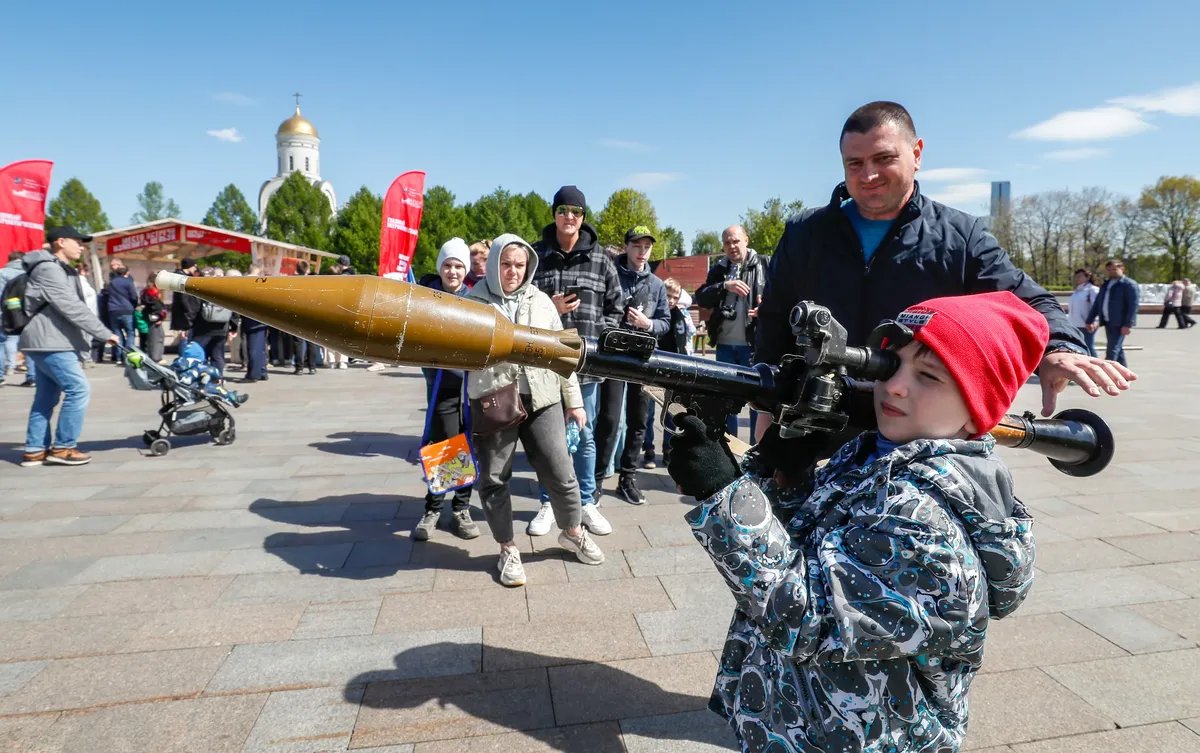
A boy learns how to hold a grenade launcher near the Museum of the Great Patriotic War on the Poklonnaya Hill in Moscow, Russia, 04 May 2024. Photo: EPA-EFE/YURY KOCHETKOV
It’s at least a half-hour wait to enter the exhibition of war trophies in a line that zig-zags around temporary barricades of the sort once widely used at protests. Those in line display a wide array of nationalist paraphernalia celebrating Victory Day, including imperial and Soviet flags, NKVD caps, medals with the orange-and-black ribbon of St George, the letter Z and the slogan “We don’t abandon our own”.
Some men in their 40s are dressed in military uniforms and even sport World War II medals. One woman, evidently a regular reader of Russia’s so-called “military correspondents” in Ukraine, proudly holds a metre-long raccoon, a living spoil of war requisitioned by Russian troops during their hurried and humiliating retreat from the city of Kherson in November 2022.
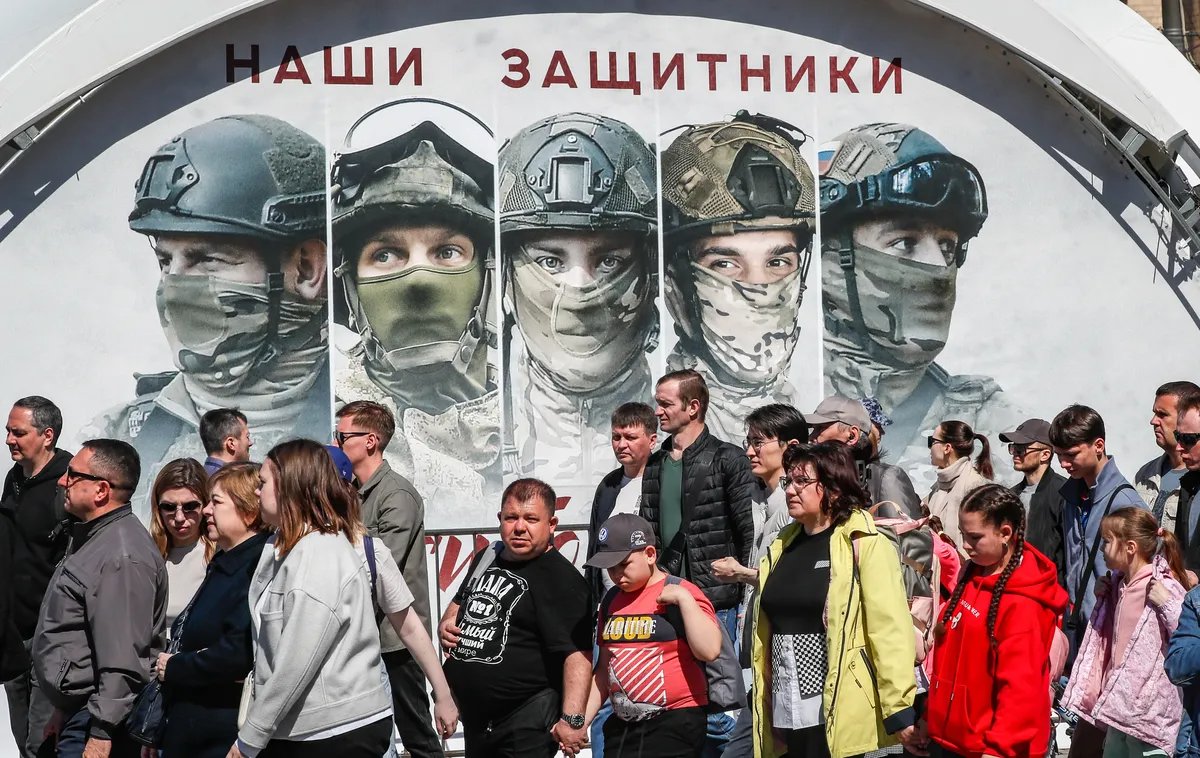
People stand near images of Russian soldiers and the inscription “Our Defenders” at an exhibition of weapons seized by the Russian Army during Russia’s “special military operation” in Ukraine, on the Poklonnaya Hill in Moscow, 01 May 2024. Photo: EPA-EFE/YURY KOCHETKOV
‘They’re traitors’
The first items of “trophy equipment” on display are armoured vehicles that rather surprisingly bear the flag of Australia on them, hardly Russia’s greatest historical enemy. Then comes a Finnish armoured transport vehicle with the NATO emblem displayed alongside the country’s flag, reminding visitors of the great geopolitical strategist Vladimir Putin’s latest achievement: making two of its longtime neutral neighbours join the defence alliance. It’s not until the sixth exhibit that a Ukrainian flag makes its first appearance. Visitors eagerly take photographs, and one says: “If everyone spat on it, the whole hill would be flooded.”
In total there are 34 items of captured military hardware on display, each with the flag of the nation responsible for its manufacture rather unsubtly emblazoned on it, perhaps to hammer home to visitors the fact that it truly is Russia against the world. Tanks dating from the Soviet era bear the Ukrainian flag, rather than a Soviet one. Women visiting with their young children examine a Turkish armoured vehicle and call Turkey “a prostitute”, adding “it’s not faithful either to us or to them”. A man smelling strongly of alcohol passes by, interjecting philosophically that the Turks are “fucking traitors”, to which the mothers nod approvingly.
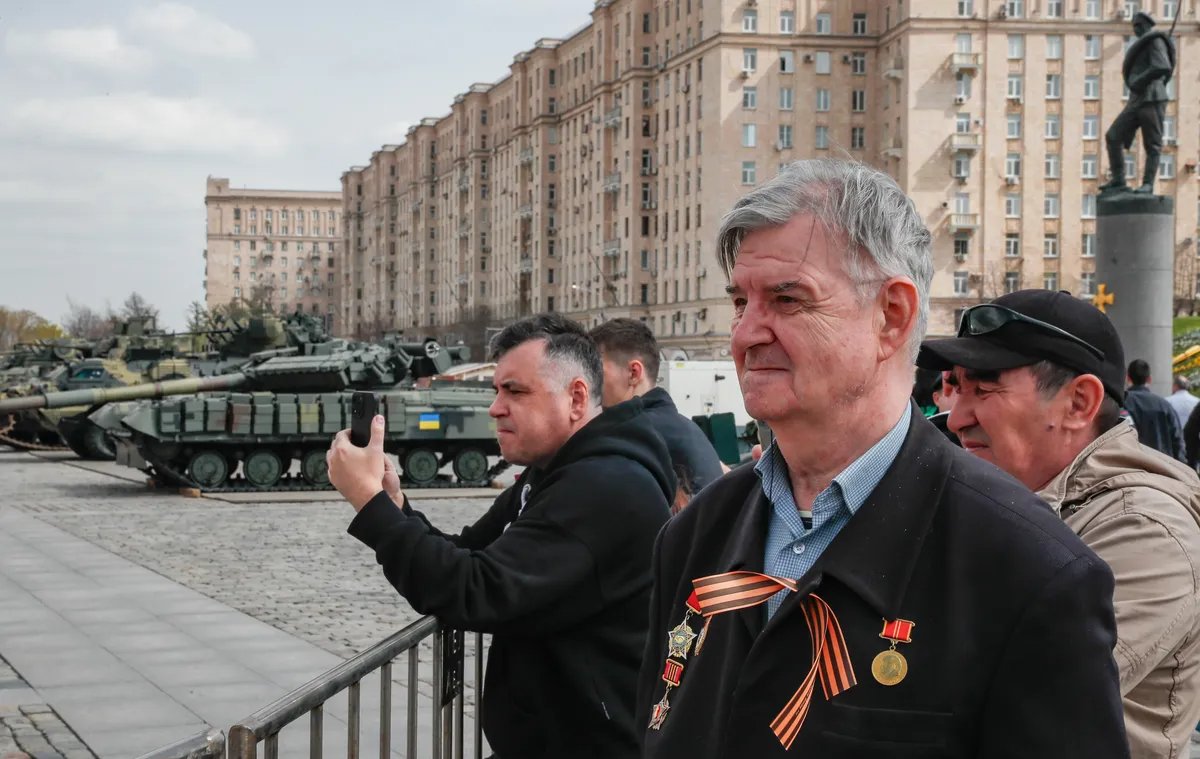
People examine military vehicles captured by Russian troops during a “special military operation” in Ukraine, on display on Poklonnaya Hill in Moscow, 25 April 2024. Photo: EPA-EFE/YURY KOCHETKOV
One of the main exhibits on display is a German Marder II tank destroyer from World War II. The information card explains that it’s a trophy from the Great Patriotic War, the name given to the Soviet involvement in the conflict, and has been so important that it’s had a separate tent set up over it bearing the legend: “History repeats itself”. A boy aged around 10 sees the German flag on the tank and says excitedly to his parents: “Germany! Our fridge is from Germany.” His mother, sensing the irony of it all, abruptly shushes him.
The exhibition ends with a multi-media display, to which staff at various Western embassies are waspishly invited to skip the line. The visuals feature photos of yet more captured NATO hardware, socialist realist paintings of the war by “Donbas artists” and, once again, repeating itself, the leitmotif of the entire show: “History repeats itself”. Then comes another announcement, repeated in four languages: “The Russian armed forces are prepared to provide the embassies of NATO countries with photos of their destroyed military equipment free of charge.” Amused and approving, the visitors file out.
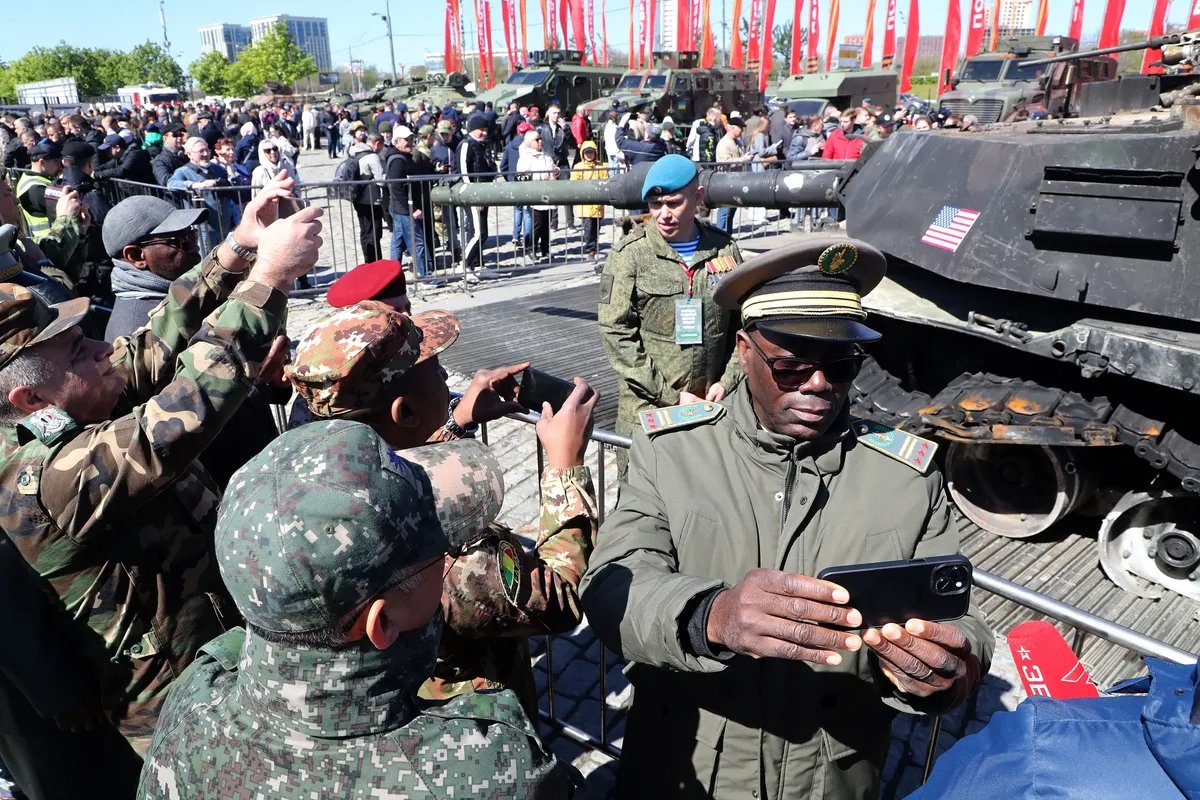
Foreign military attaches and visitors look at a US-made main battle tank M1 Abrams, which was seized by Russian troops in Ukraine, at an exhibition on the Poklonnaya Hill in Moscow, Russia, 03 May 2024. Photo: EPA-EFE/MAXIM SHIPENKOV
‘In 2025 they’ll lose’
To view the last part of the exhibition, a tent featuring minor “trophies of the Russian army”, you have to wait in line for an hour, which affords plenty of opportunity to hear what other visitors have to say about what they’ve just seen. Their impressions were exclusively positive:
“NATO sends them its old equipment deliberately and rakes in the dough. Those stupid Ukrainians fall for it.”
“That bastard Macron is promising to send his troops to Ukraine. He can go ahead. It doesn’t make any difference to our lads. We’ll burn them all, we’ll kill them all.”
“Tourists come to Moscow and say: ‘We saw Red Square and Moscow City.’ But we can say: ‘We saw how we fucked up their NATO hardware!’”
“In ’45 the old fascists lost to us, and in ’25 the new fascists will too.”
“So where are your invincible Abrams? Ah, there they are, on Poklonnaya Hill. No words, just pride!”
The final display tent contains exactly what Wagner Group founder Yevgeny Prigozhin so sorely lacked — ammunition. There are also firearms, mines and drones, not to mention a Starlink communications terminal with the SpaceX logo. Bizarrely, some weapons have Yugoslavian flags on them. The visitors look on in awe at the trophies and touch them, as if they were visiting a dystopian petting zoo. One kid announces to those around him, “this mine will go off and the whole tent will explode”, only to be told to stop talking nonsense by his parents.
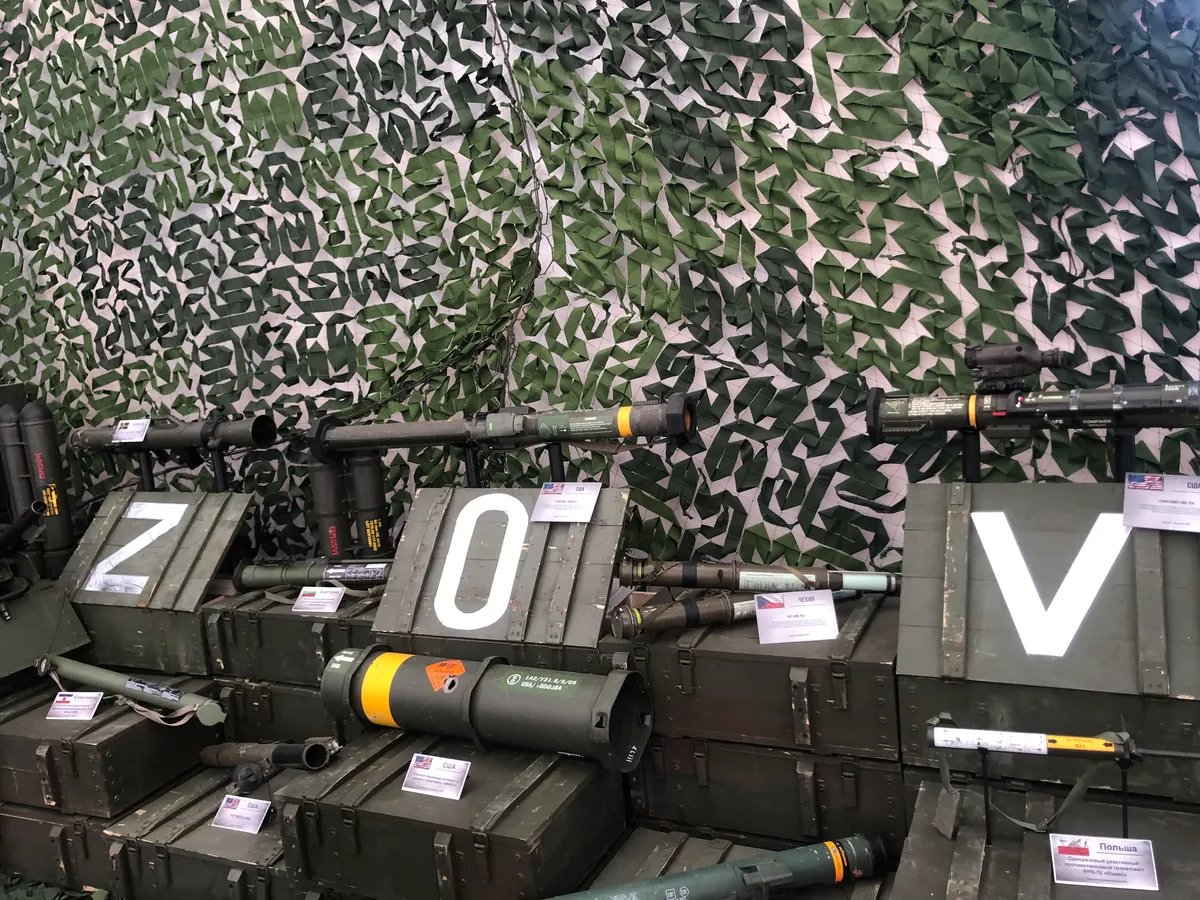
Photo: Vadim Stepanov for Novaya Europe
The statue of a Russian soldier from World War I, who fought with the British and French against a common enemy, looks down from his pedestal with apparent disdain at the crowd viewing the Western hardware. On the other side of Kutuzovsky Prospekt, the skyscrapers of Moscow City can be seen, once a symbol of Russia’s participation in the unstoppable march of globalisation. On top of a nearby building there’s a large advertisement for Aeroflot — once a window to the outside world. The cadets, satisfied with what they’ve seen on Poklonnaya Hill, set off for the crossing. They have a long walk to KFC ahead of them.
